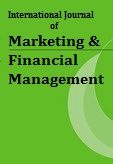EXCHANGE TRADED FUND IN INDIA- PERFORMANCE ANALYSIS WITH MUTUAL FUND AND GLOBAL PERSPECTIVES
Dr Bhupendra Kumar
Head, MBA Dept. IET Group of Institutions Alwar Rajasthan
Published Online : 2016-10-30
Download Full Article : PDF Check for Updates

International Journal of Marketing & Financial Management
Print ISSN : 2349 –2546
Online ISSN : 2348 –3954
Frequency : Monthly
Current Issue : Volume 4 , Issue 7
2016
Dr Bhupendra Kumar
Head, MBA Dept. IET Group of Institutions Alwar Rajasthan
Published Online : 2016-10-30
Download Full Article : PDF Check for Updates
ABSTRACT
An ETF refers to a diversified basket of securities that is traded in real time like an individual stock on exchange. Unlike regular open-ended mutual funds, ETFs can be bought and sold throughout the trading day like any other stock. An ETF is similar to an index fund, but the ETFs can invest in either all of the securities or a representative sample of the securities included in the index. Exchange-traded funds first came into existence in the USA in 1993. Importantly, the ETFs offer a one-stop exposure to a diversified basket of securities that can be traded in real time like an individual stock.
ETFs experience price changes throughout the day as they are bought and sold. Because it trades like a stock, an ETF does not have its net asset value (NAV) calculated every day like a mutual fund does. By owning an ETF, you get the diversification of an index fund as well as the ability to sell short, buy on margin and purchase as little as one share. Another advantage is that the expense ratios for most ETFs are lower than those of the average mutual fund. When buying and selling ETFs, you have to pay the same commission to your broker that you'd pay on any regular order.
The first ETF in India, the “NIFTY BEES (Nifty Benchmark Exchange Traded Scheme) based on Nifty 50 was launched in December 2001 by Benchmark Mutual Fund. It is bought and sold like any other stock on NSE and has all characteristics of an index fund. As of March 2013, there were 35 ETFs listed on NSE. The ETF based on Sensex is SPICE (Sensex Prudential ICICI Exchange Traded Fund) which was launched by -Prudential ICICI. Growth in Gold ETFs have seen a rising trend as shown in Following Figure however other ETFs have seen a decline in activity from 2007 to 2011.
These funds consistently outperformed the market index and generated higher returns. ETFs generated excess returns of 3% p.a. as against CNX NIFTY, which is the Indian equity market bench mark. Gold ETFs provided 13% excess returns as compared to the returns on the equity market and attracted large investments in the post financial crisis years. Data Envelopment Analysis ranked domestic and overseas fund of funds as efficient unds, which were floated by foreign Asset Management Companies (AMCs) and the AMCs with Joint Ventures in India. Among the foreign AMCs, Franklin Templeton was found to offer the most efficient fund. These efficient funds are found to have higher Sharpe ratios, indicating that the DEA ranking is in broad consensus with the evaluation done using Sharpe ratios. However large funds were not found to be efficient funds. This infers that the fund size does not indicate superior performance.